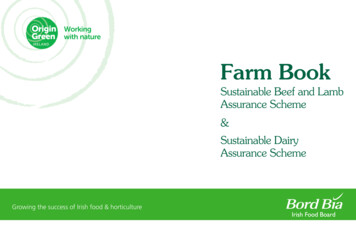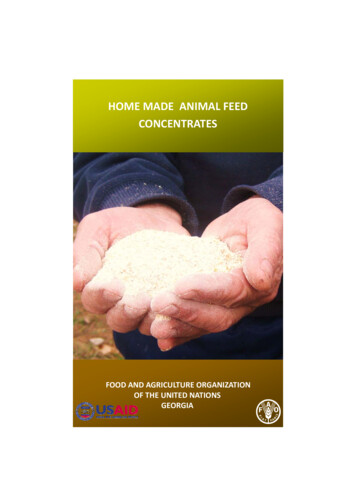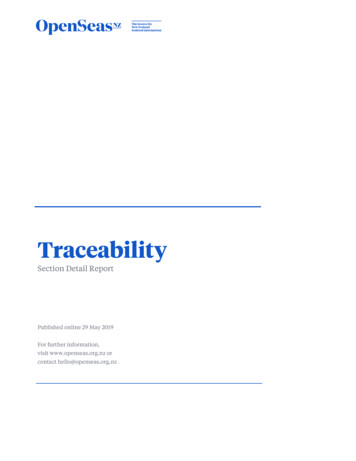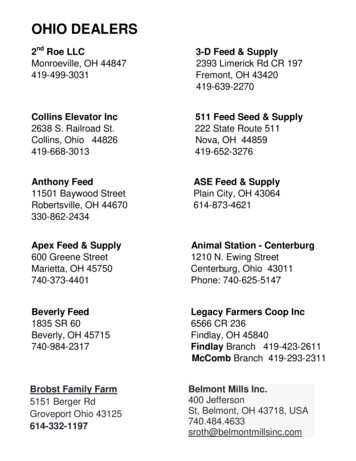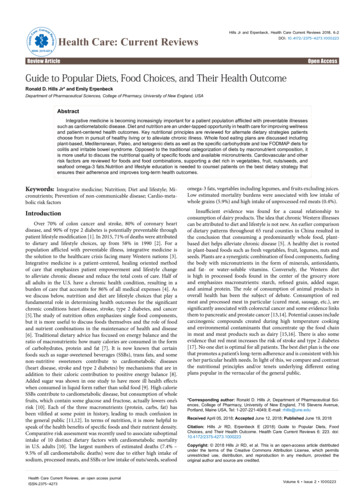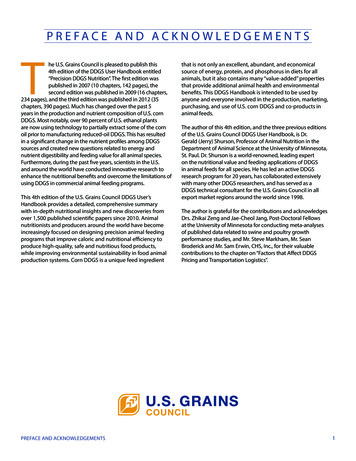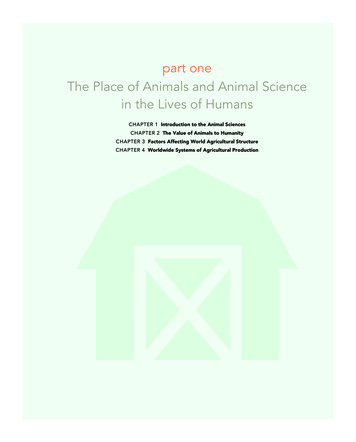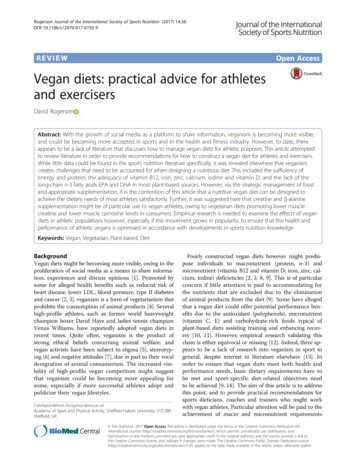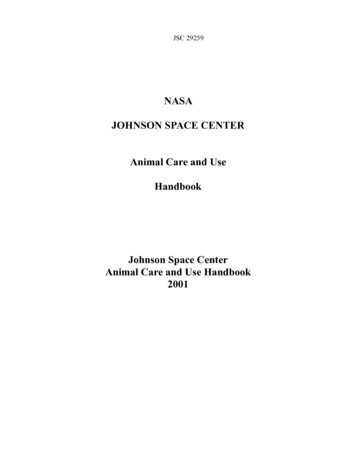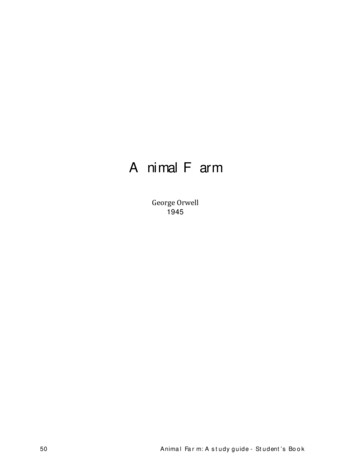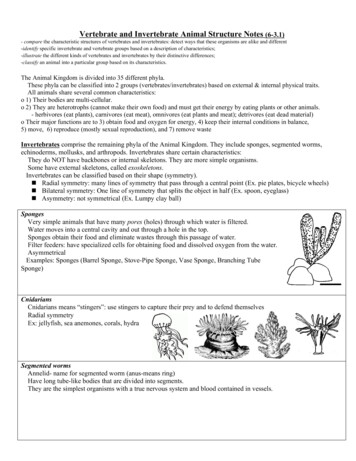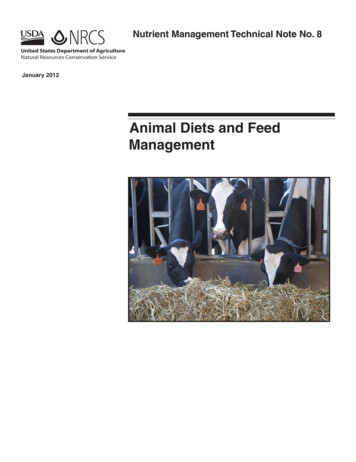
Transcription
Nutrient Management Technical Note No. 8United States Department of AgricultureNatural Resources Conservation ServiceJanuary 2012Animal Diets and FeedManagement
January 2012Cover photo: Dairy cows feeding in California. Photo courtesy of NRCS.The U.S. Department of Agriculture (USDA) prohibits discrimination in allits programs and activities on the basis of race, color, national origin, age,disability, and where applicable, sex, marital status, familial status, parentalstatus, religion, sexual orientation, genetic information, political beliefs, reprisal, or because all or a part of an individual’s income is derived from anypublic assistance program. (Not all prohibited bases apply to all programs.)Persons with disabilities who require alternative means for communicationof program information (Braille, large print, audiotape, etc.) should contact USDA’s TARGET Center at (202) 720–2600 (voice and TDD). To file acomplaint of discrimination, write to USDA, Director, Office of Civil Rights,1400 Independence Avenue, SW., Washington, DC 20250–9410, or call (800)795–3272 (voice) or (202) 720–6382 (TDD). USDA is an equal opportunityprovider and employer.Nutrient Management Technical Note No. 8, January 2012
AcknowledgmentsThis technical note outlines the findings from a Conservation InnovationGrant study conducted by Alan Sutton, Ph.D., Purdue University, WestLafayette, Indiana; Joe Harrison, Ph.D., Washington State University, Pullman, Washington; Rebecca White, Pennsylvania State University, University Park, Pennsylvania; Galen Erickson, Ph.D., University of Nebraska,Lincoln, Nebraska; Todd Applegate, Ph.D., Purdue University, West Lafayette, Indiana; and Robert Burns, Ph.D., University of Tennessee, Knoxville,Tennessee. Funding for this study was provided by the U.S. Department ofAgriculture (USDA) Natural Resources Conservation Service (NRCS).This technical note was developed under the direction of Glenn H. Carpenter, Ph.D., National Leader, Animal Husbandry, Ecological Sciences Division(ESD), Washington, DC., and reviewed by William Boyd, Leader, AnimalWaste Utilization Team, East National Technology Support Center (ENTSC),Greensboro, North Carolina; Darren Hickman, National EnvironmentalEngineer, Conservation Engineering Division (CED), Washington, DC.;Karen Hoffman, Resource Conservationist–Animal Science, Norwich, NewYork; Cherie Lafleur, Environmental Engineer, Central National Technology Support Center (CNTSC), Fort Worth, Texas; William Reck, Environmental Engineer, ENTSC, Greensboro, North Carolina; Dennis Thompson,National Range and Grazing Land Ecologist, ESD, Washington, DC.Nutrient Management Technical Note No. 8, January 2012
This page intentionally left blank.Nutrient Management Technical Note No. 8, January 2012
Animal Diets and Feed ManagementIntroductionFeed management is managing the quantity of nutrients fed to livestock and poultry for their intendedpurpose. This involves development of diets thatsupply the quantity of available nutrients required bylivestock and poultry for maintenance, production,performance, and reproduction. Supplying nutrients inexcess of an animal’s requirement results in additionalnutrients being excreted. In many circumstances,confined livestock and poultry operations find themselves under a whole-farm nutrient imbalance. In thisscenario, there are more nutrients being importedon the farm than is being exported from the farm orutilized by current cropping rotations. As a result, soilsaturation with various nutrients, especially phosphorus (P), or excess losses of nitrogen (N), can have adeleterious impact on the environment through runoff,soil erosion, and leaching. Phosphorus losses from soilemptying into surrounding fresh water bodies can leadto eutrophication (Carpenter et al. 1998; Correll 1999;Sharpley et al. 1994). Nitrate leaching from soil intodrinking waters can lead to fatalities in humans (Cameron et al. 1996) and livestock (Rasby et al. 1988). Anaerobic degradation of manure or other organic mattersources (animal mortality, spoiled feed) from the operation can cause air quality pollution from the emission of ammonia and other nitrogenous compounds,sulfurous compounds, volatile organic compoundsthat often are odorous, and can cause greenhouse gas(GHG) and acid rain effects.The NRCS Conservation Practice Standard (CPS)Code 592, Feed Management, was developed withthe purpose of supplying the quantity of availablenutrients required by livestock and poultry for maintenance, production, performance, and reproduction,while reducing the quantity of nutrients, especially Nand P, excreted in manure by minimizing the overfeeding of these and other nutrients. As a result of fulfillingthis purpose, the livestock and poultry operations canimprove the whole-farm nutrient balance and minimizethe threat of nutrients from manure impacting waterand air quality. In addition, using proper feed management practices may improve net-farm income by feeding nutrients more efficiently. The aim of this technicalnote is to outline various aspects of animal nutrition,feed formulation, and feed management practices toenhance nutrient efficiency, reduce nutrient excretion,and potentially improve net income from livestock andpoultry farms. This document presents general background information about animal nutrition and feedmanagement practices.Definitions of nutrition and feedmanagement termsNutrition termsNutrient—any chemical element or compound in thediet that supports reproduction, growth, lactation, ormaintenance-of-life processes.Six classes of nutrients—water, proteins and aminoacids, carbohydrates, lipids, vitamins, and minerals.These nutrients support cellular needs for water, fuel,structural constituents (skin, muscle, bone, nerves,fat), and metabolic regulation.Enzyme—an organic catalyst that speeds or slows achemical reaction without being used up in the reaction.Essential nutrients—nutrients required in the dietbecause they cannot be synthesized within the body insufficient amounts to satisfy metabolic needs.Feedstuff—any material made into or used as feed. Afeed ingredient.Diet—a mixture of feedstuffs used to supply nutrientsto an animal.Ration—a daily supply of feed.Macrominerals—essential minerals that are requiredin relatively large amounts (i.e., calcium, phosphorus,magnesium, sodium, potassium).Microminerals/trace elements—essential mineralsthat are required in smaller quantities (i.e., zinc, iodine, selenium, copper, iron, manganese).Nutrient Management Technical Note No. 8, January 2012
Animal Diets and Feed ManagementApparent digestibility—the percentage of a feednutrient that is digested and absorbed from the gastrointestinal tract, as indicated by nutrient intake minusfecal nutrient output.Rumen—the largest of the four stomach compartments in the adult ruminant. The site of active microbial digestion.Ruminant—an animal with a functional rumen compartment in the stomach plus three other compartments. A cud-chewing animal. In U.S. agriculture,typically a cow, sheep, or goat.Monogastric—a nonruminant. An animal that has asimple stomach, typically poultry, swine, or even human.Roughage—A feed low in digestible energy and high infiber, like hay or grass.Feed management termsDry matter (DM)—the portion of a sample remainingafter water has been removed.Crude protein (CP)—the content of nitrogen in asample multiplied by the factor 6.25 to provide an estimate of the protein content of the sample.Ether extract (EE)—composed of fats and fatty acidesters. This method of analysis is applicable for thedetermination of crude fat in dried forages and mixedfeeds.Ash—residual minerals remaining after all combustible material has been burned off in a furnace.Crude fiber (CF)—structural carbohydrates of plants(i.e., hemicellulose, cellulose, and lignin).Units of measure Example 1. Dry matter (DM) and ashInitial sample weight 100gSample weight after drying (100 ºC) 50gSample weight after furnace ashing (600 ºC) 10gpercent DM 50 percentpercent ash 10 percentSample weight after drying 100 percent DMInitial sample weightSample weight after furnace ashingInitial sample weight2 Example 2. Crude proteinProtein consists of 16 percent nitrogen (N);therefore, 6.25 times the amount of N in thesample equals the total amount or percentageof protein in the sample.Weight of sample 100gAmount of N in sample 3000mg/kgpercent crude protein 18.75 percentAmount of N in sample 6.25Weight of sample 100 percentcrude protein Example 3. Apparent digestibilityNutrient intake (NI) 20gFecal nutrient output (NO) 5gApparent digestibility (percent) 75 percent[( NI – NO)NI] 100 apparent digestibilityGeneral nutrition principlesThere are six classes of nutrients: proteins, carbohydrates, fats, minerals, vitamins, and water. The rolesof certain feed ingredients in a diet can be divided intogroups according to how they function in the body. Forinstance, corn generally provides the greatest sourceof carbohydrates (for energy) and soybean meal isused primarily as a protein source. The regulatory nutrients include vitamins, water, minerals, and proteins.The structural nutrients also include water, minerals,and proteins, as well as fats. The nutrients that primarily supply energy are fats and carbohydrates, butproteins can be used for energy, also.Protein (N)Protein is made up of amino acids which are calledthe “building blocks” of muscle. Chemically, proteincontains nitrogen, carbon, hydrogen, oxygen, and maycontain sulfur. Typically, nitrogen in protein is approximately 16 percent of the protein molecule; therefore,to convert nitrogen in feeds to a crude protein equivalent, the formula is: N 6.25. Specific levels and ratiosof amino acids are required by the animal to grow,reproduce, and produce milk and eggs; therefore, nutritionists try to formulate diets to contain the correctratios and levels of the amino acids. This is especiallyimportant for pigs and poultry. For sheep, beef cattle,and dairy cattle, nonprotein nitrogen, such as urea,can be consumed and the amino acids will be createdin the digestive system by microorganisms to meet theneeds of the animal. 100 percent ashNutrient Management Technical Note No. 8, January 2012
Animal Diets and Feed ManagementCarbohydrates (energy)Carbohydrates comprise the largest proportion oflivestock rations by providing energy and bulk in thediet. The carbohydrate fraction of plant feedstuffscomprises between 70 to 80 percent of the dry matter of forages and cereal grains, respectively (Kellemsand Church 2002). Chemically, carbohydrates containcarbon, hydrogen, and oxygen. Glucose, lactose, galactose, maltose, sucrose, and starch are the main components of carbohydrates that provide energy; however,the ruminant animal can create volatile fatty acids inthe digestive system from specific carbohydrates thatcan be used for energy. These carbohydrates that areused in plants and cereals for structural purposes arecellulose, hemicellulose, and lignin.Fats (energy)Fats and oils provide additional energy in the diet andaids in the absorption of vitamins. Chemically, fatscontain carbon, oxygen, and hydrogen, but they canbe arranged in a triglyceride form with different lengthfatty acid units. The energy value of fats is 2.25 timesmore potent compared to carbohydrates.MineralsMinerals, including calcium (Ca), chlorine (Cl), copper(Cu), iron (Fe), magnesium (Mg), manganese (Mn),phosphorus (P), potassium (K), and selennium (Se),are important for structural integrity and are criticalcomponents for maintaining the ionic balance andmetabolic activity of the animal. Inorganic sources ofminerals are often added to diets to provide the correct level of biologically available sources of mineralsand to balance levels of minerals that are in other feedingredients in the diet.Vitamins (A, D, E, K, B-complex)Vitamins are provided in small quantities for animaldiets to assist in metabolic activities in the animal. Certain vitamins can be synthesized in animals; however,commercial vitamin mixes are added to the diet forthose not synthesized and because normal plant feedsources do not contain sufficient amounts of availablevitamins.WaterApproximately 50 to 70 percent of body mass of adultsand up to 90 percent of body mass of newborn animalsis water (Pond, Church, and Pond 1995). There aretypically two major functions of water: component inmetabolism, and factor in controlling body temperature. Some of the biological functions of water includeaiding digest transport through the gastrointestinaltract, and solvent in blood, tissue fluids, secretions,and excretions.Access to water may occur through several differentavenues. One major source of water intake is throughfree access to drinking water (table 1). Poor waterquality will negatively impact the animal’s intake andtherefore reduce animal performance. Water qualitycan be compromised by high levels of salts, nitrates,sulfates, fluoride, pathogenic microorganisms, algae,pesticides, dissolved solids, and industrial compoundsthat may be polluting the water supply (EPA 2006;Kellems and Church 2002; Hairston and Stribling1995). Secondly, water can be consumed through thewater content of ingested feedstuffs. For example, ananimal consuming 20 pounds of corn silage per dayhas the potential to consume 13 to 15 pounds of waterper day (Kellems and Church 2002).Classification of FeedsFeeds are also classified based on their chemicalcharacteristics (National Research Council (NRC)).For instance, forages or roughages commonly fed tocattle and sheep, have more than 18 percent fiber.Energy feed sources, such as cereal grains, have lessthan 20 percent protein, and less than 18 percentfiber. Protein supplements, such as soybean meal andvarious byproduct sources, have greater than 20 percent protein and less than 18 percent fiber. Minerals,vitamins, and additives are specific for the nutrientneeded in the diet for specific functions in the animal.Example feed ingredients for each class of feeds isshown in table 2.Table 1Expected water consumption ofvarious classes and species of adultlivestock in a temperate climateAnimalLiters/dayPounds/dayBeef cattle22–6648–145Dairy urkeys0.4–0.60.9–1.3Sheep and goatsNutrient Management Technical Note No. 8, January 20123
Animal Diets and Feed ManagementTable 2Classes of feeds according to the NRCS systemClassTrait(s)ExamplesDry forages or roughageSucculent forages or roughageSilages 18% fiber 18% fiber 18% fiberEnergy feedsProtein supplements 20% proteinand 18% fiber 20% proteinand 18% fiberMineral supplementsGuaranteed analysisVitamin supplementsGuaranteed potencyAdditivesSpecificHay, straw, seed hulls, fodder, stoverPasture, green chop, cannery residuesWhole-plant grain crops, wilted or low-moisturegrasses or legumesCereal grains, milling by-products, roots andtubers, brewery by-productsAnimal by-products (meat scraps)Marine by-products (fish meal)Avian by-products (hydrolized feathers)Plant by-products (soybean meal, cottonseedmeal, linseed meal, corn gluten meal)Steamed-bone mealDicalcium phosphateIodized saltTrace mineralized saltVitamin A acetateVitamins A, D, EB-complex vitaminsAntiobiotics (chlortetracycline, oxytetracycline,tylosin)Coloring materialsFlavorsHormonesMedicantsSource: Adapted from National Academy of Science publicationsDigestive processesThe initial digestive process involves the intake of feedingredients provided to meet the maintenance, production, and reproduction requirements of the animalsinvolved. The requirements for production are affectedby stage of growth and the type of production (e.g.,meat, milk, eggs) involved. How well the animal canretain nutrients for productive purposes depends onthe availability of the nutrients in the diet, absorption,metabolism, and retention, and ultimately, the excretion of nutrients. The quantity of nutrients excreted byanimals is affected by three main factors: the amount of dietary nutrients consumed the efficiency with which they are utilized andretained by the animal for growth and other functions the amount of normal metabolic losses (endogenous). In other words, the amount of excretednutrients can be expressed as:Nutrients excreted nutrient intake – nutrientutilized nutrients from endogenous sources4The primary means of reducing the amount of nutrients excreted by animals is to decrease the amountthat is consumed and increase the efficiency of utilization (digestibility, absorption, and retention) of thedietary nutrients for formation of the product.The goal of efficient and productive feeding of animalswithin economic and environmental constraints is toprovide essential available nutrients for maintenanceand production with minimal excess amounts.Nutrients in feeds can vary considerably, and not allnutrients in feeds are available to the animal. Therefore, any means of increasing the digestibility oravailability of nutrients will increase the potential foranimal use and retention and reduce the amount of thenutrients excreted. There is increasing interest todayin using enzymes, genetically modified feed ingredients, and feed processing technologies to enhance theavailability of nutrients to meet the specific animalneeds and reduce excretion of nutrients. In addition,a routine feed analysis program is imperative so dietscan be formulated and periodically adjusted to meetbut not exceed nutrient requirements of the animal.Nutrient Management Technical Note No. 8, January 2012
Animal Diets and Feed ManagementFeed management systemsFeeding farm animals involves a series of diets withall nutrients required for maintenance, growth, reproduction, and production of products (meat, eggs, andmilk). While different feeding systems are utilized, themost common approach is to use diet formulation tocombine exact quantities of feed ingredients into a total mixed ration (TMR) for delivery to the animals. TheTMR is presented before meat-type (broiler) chickens,layer (egg-producing) chickens, turkeys, ducks, andgrowing pigs constantly, whereas, the TMR is deliveredto dairy cows and fattening cattle generally two tothree times per day. Breeding animals are generally fedonce or twice daily in an attempt to control weight.Feed formulationFormulation of diets involves combining various available, economical sources of feed ingredients into aration that animals will consume, digest, and utilizethe nutrients to meet the nutrient needs of the animalfor maintenance or productive purposes. The individual responsible for ration formation should be awareand understand the concepts of nutrition, the animal’sproduction status, and the physical and chemicalcomposition of various available feedstuffs. The NRChas developed nutrient requirements for all species ofanimals that can be used as a reliable tool for rationformulation for a particular stage of production. Animal nutrient requirements can also be obtained fromextension or university publications. These may provide modifications to nutrient requirements dependingon regional differences in environment, animal, or feedconditions.Choosing feed ingredients for ration formulations mayfocus on developing least-cost rations or the mostpredicted profitable ration based on productivity. Insome cases, the impact of ration formulation on nutrient excretion is not considered. However, with adoption of CPS Code 592, Feed Management, and withthe development of a Feed Management Plan (FMP),nutrient excretion is identified as another importantconsideration when formulating rations.Maintaining the nutritional quality of feed ingredientscan be difficult. Feedstuff quality can be altered byphysical or genetic differences. Physical differencesinclude the amount and type of soil nutrients availableduring plant growth, temperature, water supply, lengthof photoperiod and light intensity, cultivation practices, plant maturity at harvest, and storage. Geneticvariety also plays a significant role in determining thenutrient composition and quality of a feed ingredient.Improvements in genetic selection have allowed fornovel nutrient-dense plant variety development. Anexample of this is a nutrient-enriched corn that contains approximately 30 percent more lysine, 50 percentmore total sulfur-containing amino acids, 18 percentmore threonine, and 6 percent more metabolizableenergy than a normal corn variety. Another exampleis a low-phytic acid corn with the benefit of containing approximately 75 percent available P comparedto yellow dent corn at about 12 percent available P.Low-phytic acid corn in broiler diets resulted in a50-percent reduction in phytate-bound dietary P translating into a 20-percent reduction in fecal P excretioncompared to birds fed the yellow dent corn diet. Similar genetic changes in chemical composition are alsoavailable for soybean varieties. Because of such feedingredient variations, a subsample of each ingredientshould be analyzed for nutrient composition priorto diet formulation. This feed management practiceallows optimization of the ration to the animal’s nutrient requirements. Many States have university orcommercial laboratories specializing in feed analysis.Computer software programs are available for moreaccurate diet formulation.Feed storage, handling, and processingFeed ingredient qualityFeed ingredient quality (grains, forages, fat, minerals, and vitamins) is a critical part of animal nutrition.Good storage facilities and conditions are vital. However, the quality of the grains and forages starts witha good initial quality product at harvest. To ensureproperly stored grain in bins, high-moisture grainsneed to be dried to at least 14 percent moisture forlong-term storage and no more than 16 percent moisture for winter storage. Grain temperatures should notexceed 82 C or there will be some browning, evidenceof decreased lysine availability; therefore, an adequatefan system for cooling is desirable in some climates.Fat should not be stored at temperatures above 60 C,with 49 C being most ideal. Antioxidants extend thetime period before rancidity of the oil starts. Vitaminstability varies greatly among vitamins, depending onconditions they are exposed to and storage time. Storage of the vitamin premixes should be in a cool, dark,dry place. Moisture, visible and ultraviolet light, heat,and contact with certain trace minerals are the mostcommon factors that reduce vitamin stability.Nutrient Management Technical Note No. 8, January 20125
Animal Diets and Feed ManagementPelletingPelleting of diets is an effective way to improve feedefficiency (generally 4 to 6 percent) for all phases ofswine and poultry production (Wondra et al. 1995;Szabo 1988). The improved feed efficiency is due toa slight reduction in feed wastage and a slight improvement in digestibility of the diet because the steam heatof the pelleting process gelatinizes some of the starch,thereby increasing the susceptible area of the feed todigestive enzyme hydrolysis. A side benefit to pelletingthe diet is a 10 to 15 percent reduction in dry matterand N excretion caused by the reduced wastage andimproved feed efficiency and digestibility. On the negative side, pelleting does increase the cost of feed.at harvest, compaction of the material during filling ofthe storage structure to exclude oxygen, and sealingof the storage structure when the structure is full.GrindingFine grinding of feed is effective in improving feedutilization and decreasing dry matter, N, and P excretion. By reducing the particle size, the surface area ofthe grain particles is increased allowing for greaterinteraction with digestive enzymes. Cereal grains withhard-seed coats (grain sorghum, barley, and triticale)have the greatest improvements in digestibility by processing, but even the processing of corn is of economicbenefit. When particle size is reduced from 1,000 to 400micrometers, dry matter and N digestibility increase byapproximately 5 to 6 percent (Wondra et al. 1995; Haleand Thompson 1986). As particle size is reduced from1,200 to 600 micrometers, dry matter and N excretionare reduced by 20 and 24 percent, respectively. Therecommended particle size is between 650 and 750micrometers for swine and poultry. Reducing particlesize further increases the energy costs of grinding andreduces the throughput of the mill below the economicreturns for finer grinding as well as increasing theincidence of stomach ulcers in pigs (Healy et al. 1994).Ruminants require larger particle sizes because thereis a rumen stimulation factor required to provide goodhealth of the rumen. The particle size can vary depending on the source or type of diet fed and the performance required of the animal.Feed management practicesFermentationSilage is the product of forages or a whole-plant cereal(corn silage) with a higher moisture level that havebeen chopped and placed in a storage structure thatexcludes oxygen so that the forages undergo acidfermentation. Anaerobic microorganisms metabolizesugars and produce volatile fatty acids that reduce thepH of the forages, eventually stopping the fermentation process and preserving the forage until it is fedto ruminants. Storage structures used to preservethe forages include bunker silos, upright silos (eitherglass-lined steel or concrete), or sealed plastic bags.Important components for high-quality silage requirethe proper maturity and moisture level of the foragesGender (split-sex) feeding—Place animals of thesame gender together. Split-sex feeding divides theanimals by gender so that diets can be formulated tomeet the special nutrient needs of each sex.6Other processesExtrusion, micronization, and steam flaking are examples of other processes designed to reduce the particle size, break the seed coat, or change the chemicalstructure of the feed ingredient to improve nutrientor energy digestion and improve the ability of enzymeactivity on the feed resource. In most cases, theseprocesses improve nutrient utilization and efficiencyresults with less nutrient excretion.Recommended feed management practices for aparticular operation may include considering processing options (described previously), implementation ofgrouping strategies, including grouping by gender andincreasing the number of production groups, appropriately adjusting diets based on climatic factors, andminimizing feed wastage.Grouping—Place animals of similar ages, weights,and production levels together so that more specificrations can be developed with a minimal chance ofoverfeeding nutrients.Phase feeding—Use multiphase feeding versusminimal-phase feeding. Phase feeding provides a series of diets that are formulated to more closely meetthe nutrient needs of the animal at a particular stageof growth or production (Henry and Dourmad 1993).Dividing the growth period into several periods witha smaller spread in body weight, milk production, oregg production status allows producers to providediets that more closely meet the animal’s nutrientrequirements and significantly reduces nutrient excretion and wastage.Climate—Adjust diet to meet specific climatic conditions, i.e., temperature, wind, precipitation, or adjustthe building climate to optimize nutrient utilization.Wastage—Minimize spillage of feed and water intothe manure management system. Wastage is a veryimportant concept because all of the nutrients foundin the feed have to be dealt with in the environmentrather than just those not utilized in meat, milk, or eggNutrient Management Technical Note No. 8, January 2012
Animal Diets and Feed Managementproduction by the animal. There are a variety of feedand watering systems that can be used with variableimpacts on feed and water spillage. Wet-dry feedersfor swine generally will reduce the volume of waterspillage and the volume of liquid manure for storageby 30 to 50 percent primarily due to much less waterwastage. Specialized feeder designs and adaptationsthat can be used to minimize wastage are available forall livestock types.Diet manipulation factorsDiet formulation and ingredient selection considerations include formulation based on feed-available nutrients, use of growth promotants, genetic factors, useof specialty feeds and additives, and water supplies.Available nutrients—If the biological availability ofnutrients in feed ingredients is known, diets can beformulated more accurately from feed ingredients tosupply needed nutrients and reduce excess nutrientexcretions.Genetics—Knowing the genetic capability of theanimals producing meat, milk, and eggs is critical sothat adjustments can be made for diet formulation toprovide adequate nutrients. Feed intake levels andresponses to environmental conditions, i.e., climate,disease pressure, and housing system are importantalso for formulation adjustments.Growth promotants—Antibiotics, enzymes, probiotics and other feed additives that are growth promotersor enhance the health of animals will increase feedefficiency and animal productivity. Growth promotersTable 3can reduce nutrient excretion by increasing nutrientutilization.Specialty feeds—Providing specific feed ingredients(e.g. high-oil corn, nutrient-dense corn, low-phytatecorn, and soybeans) helps achieve a proper balance orincreased availability of nutrients.Water supplies—Water supply sources can makea significant contribution to mineral intakes of theanimal. Routinely analyze water sources and accountfor any contribution of minerals from drinking waterwhen making necessary adjustments to the diet formulation.Supplemental phosphorus—Reduce supplemental Pand add phytase to swine and poultry diets to reduceP excretion. Remove all supplemental P in beef cattlediets and most of the supplemental P in dairy cattlediets to reduce P excretion.Crude protein—Reduce dietary protein content andadd supplemental amino acids to swine and poultrydiets; reduce protein and select N source
Ruminant—an animal with a functional rumen com-partment in the stomach plus three other compart-ments. A cud-chewing animal. In U.S. agriculture, typically a cow, sheep, or goat. Monogastric—a nonruminant. An animal that has a simple stomach, typically poultry, swine, or even hu-
